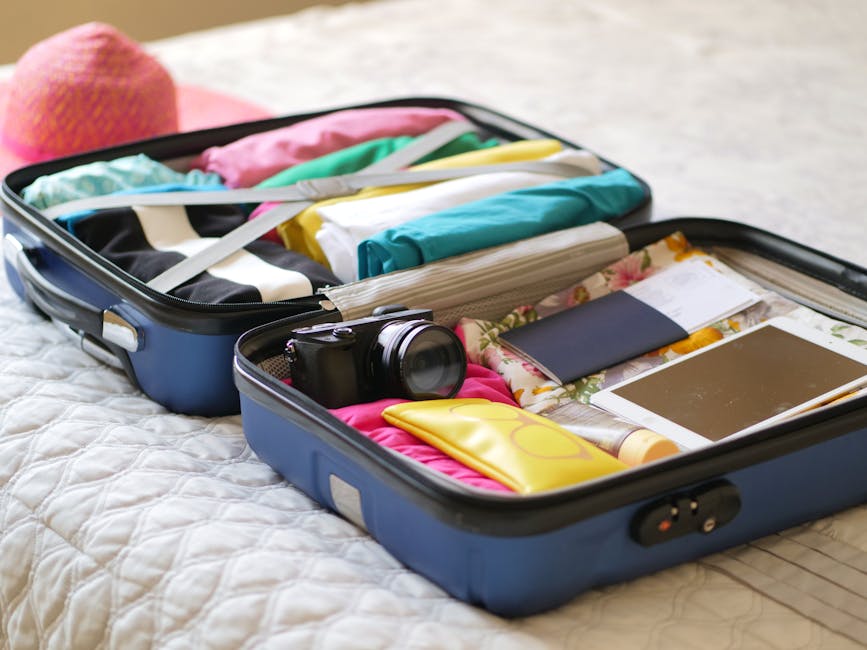The Ultimate Japan Packing List: Don't Forget These Essentials For Your Dream Trip

The Ultimate Japan Packing List: Don't Forget These Essentials For Your Dream Trip
Hey friend! So, you're heading to Japan? That's amazing! I'm so excited for you. Japan is, without a doubt, one of the most incredible places I've ever visited. From the bustling streets of Tokyo to the serene temples of Kyoto, it's a country of captivating contrasts and unforgettable experiences. But before you get swept away by visions of cherry blossoms and delicious ramen, let's talk about something crucial: packing. Packing smart can make or break your trip, so I'm here to share my ultimate Japan packing list – the stuff I learned from my own adventures (and a few packing mishaps!) to help you have the smoothest, most enjoyable trip possible.
Before We Start: Mindset Matters

Okay, before we dive into the nitty-gritty of what to pack, let's quickly address the mental aspect. Packing for Japan isn't just about shoving clothes into a suitcase. It's about thinking strategically about your itinerary, the time of year you're traveling, and, most importantly, packing light. Seriously, trust me on this. You'll be doing a lot of walking, navigating public transport (which is fantastic, by the way, but can get crowded), and maybe even moving between cities with your luggage. Do yourself a favor and embrace the "less is more" philosophy.
Pro Tip: Start packing at least a week before your trip. This gives you time to really think about what you need, avoid last-minute panic buys, and make sure everything fits comfortably in your bag.
The Core Essentials: Clothing & Personal Items

Let's start with the basics – the clothes you'll be wearing and the personal items you can't live without. This is where you'll be making the most crucial decisions, so pay close attention!
- Clothing: Layers are Key
- Tops: Pack 5-7 versatile tops. Think t-shirts, long-sleeved shirts, and a nice blouse or button-down for evenings out or temple visits. Choose breathable fabrics like cotton or linen.
- Bottoms: 2-3 pairs of pants or jeans, a skirt (optional), and a pair of comfortable shorts (if visiting during warmer months). Consider quick-drying materials that are wrinkle-resistant.
- Outerwear: A lightweight jacket or cardigan, a waterproof jacket (especially important if traveling during the rainy season), and a heavier coat or sweater for colder months.
- Underwear & Socks: Pack enough for each day of your trip. Consider moisture-wicking socks for all the walking you'll be doing.
- Pajamas: Pack a comfortable set of pajamas or loungewear.
- Shoes: Comfort is King (and Queen!)
- Walking Shoes: Your primary pair. Make sure they're supportive and comfortable for long distances.
- Sandals or Flip-flops: Useful for onsen (hot springs) and for relaxing in your hotel room.
- Dress Shoes (Optional): Only pack these if you plan on attending formal events or dining at upscale restaurants.
- Personal Items: The Necessities
- Toiletries: While you can buy most toiletries in Japan, it's always a good idea to bring travel-sized versions of your essentials. Don't forget shampoo, conditioner, body wash, toothbrush, toothpaste, deodorant, and any skincare products you use regularly.
- Medications: Bring any prescription medications you need, along with a copy of your prescription. Also, pack some over-the-counter essentials like pain relievers, allergy medication, and motion sickness pills.
- Sunscreen: The sun can be surprisingly strong in Japan, even during cooler months.
- Insect Repellent: Especially important if you're planning on spending time outdoors, particularly in rural areas.
- Makeup (Optional): Pack your essential makeup items.
Japan's weather can be surprisingly variable, even within the same season. Layering is your best friend! Pack items that can be easily mixed and matched to adapt to different temperatures.
You will be doing A LOT of walking in Japan. Seriously, a lot. Invest in a pair of comfortable, broken-in walking shoes. I cannot stress this enough! Also, consider bringing:
Tech Gear: Staying Connected & Capturing Memories

In today's world, technology plays a big role in our travels. Here's what you should consider packing to stay connected and capture those amazing moments:
- Smartphone:
Of course! Your smartphone is your lifeline for navigation, translation, communication, and photography. Make sure it's unlocked so you can use a local SIM card or pocket wifi.
- Portable Charger:
Absolutely essential! You'll be using your phone a lot, and battery life can drain quickly. A portable charger will keep you powered up throughout the day.
- Camera (Optional):
If you're a photography enthusiast, consider bringing a dedicated camera for higher-quality photos and videos. However, your smartphone camera is usually sufficient for most travelers.
- Adapter:
Japan uses Type A and B plugs, which are different from most other countries. You'll need an adapter to charge your electronics.
- Pocket Wifi or SIM Card:
Staying connected is crucial for navigation, translation, and staying in touch with family and friends. You can rent a pocket wifi device at the airport or purchase a local SIM card. I personally prefer pocket wifi for its convenience and ability to connect multiple devices. Sakura Mobile is a good choice.
- Headphones:
For listening to music or podcasts on trains and buses.
Important Documents & Money Matters

Don't forget the essential documents and money-related items you'll need for your trip. Getting these right is crucial for a smooth and stress-free experience.
- Passport:
The most important item! Make sure your passport is valid for at least six months beyond your planned return date.
- Visa (If Required):
Check visa requirements for your nationality before you travel. Many nationalities can enter Japan for tourism purposes without a visa for a certain period of time.
- Flight/Train Tickets:
Print out copies of your flight and train tickets, or save them on your phone. Having a physical copy can be helpful in case of technical issues.
- Hotel Reservations:
Print out copies of your hotel reservations, or save them on your phone.
- Japan Rail Pass (If Applicable):
If you're planning on traveling extensively by train, a Japan Rail Pass can save you a lot of money. Make sure to purchase it before you arrive in Japan.
- Credit Cards & Cash:
While credit cards are becoming more widely accepted in Japan, it's still a good idea to carry some cash, especially when visiting smaller towns and temples. Notify your bank of your travel plans to avoid having your card blocked.
- Copies of Important Documents:
Make copies of your passport, visa, flight tickets, and credit cards. Store them separately from the originals in case of loss or theft. You can also email them to yourself for easy access.
- Travel Insurance Information:
It's always a good idea to have travel insurance in case of unexpected events. Print out your insurance policy and keep it with your other important documents.
Health & Safety Essentials

Your health and safety should always be a top priority when traveling. Here's what you should pack to stay healthy and safe in Japan.
- Hand Sanitizer:
Essential for keeping your hands clean, especially when using public transportation or eating street food.
- Wet Wipes:
Useful for cleaning surfaces or wiping your hands when soap and water aren't available.
- Face Masks:
While mask mandates have been relaxed, it's still common to see people wearing masks in Japan, especially during flu season. It's a good idea to pack a few masks just in case.
- First-Aid Kit:
A small first-aid kit with band-aids, antiseptic wipes, pain relievers, and any other medications you need.
- Motion Sickness Pills:
If you're prone to motion sickness, pack some motion sickness pills for long train or bus rides.
- Prescription Medications:
As mentioned earlier, bring any prescription medications you need, along with a copy of your prescription.
- Japanese Phrasebook or Translation App:
While many people in tourist areas speak English, it's helpful to know some basic Japanese phrases. A phrasebook or translation app can be a lifesaver in situations where English isn't widely spoken. Google Translate is pretty reliable.
The "Nice-to-Haves": Comfort & Convenience Items

These items aren't strictly essential, but they can definitely make your trip more comfortable and convenient. These are the things I often find myself reaching for and being grateful I packed!
- Travel Pillow:
For comfortable naps on long train or bus rides.
- Eye Mask & Earplugs:
Essential for getting a good night's sleep in hotels or hostels.
- Reusable Water Bottle:
Staying hydrated is important, especially when you're doing a lot of walking. A reusable water bottle will save you money and reduce plastic waste.
- Snacks:
Pack some snacks for long train or bus rides, or for when you're feeling peckish between meals. While Japan has amazing snacks available everywhere, having some familiar comforts can be nice.
- Small Backpack or Daypack:
For carrying your essentials during day trips.
- Foldable Shopping Bag:
Useful for carrying souvenirs or groceries.
- Travel Journal & Pen:
For recording your memories and experiences.
- Japanese Language Learning App:
Apps such as Duolingo can help you learn basic Japanese before and during your trip.
- Portable Clothesline:
For drying clothes in your hotel room.
- Universal Sink Stopper:
Because not all sinks have stoppers, and you might want to wash something.
Packing for Specific Activities: Tailoring Your List

Your packing list should also be tailored to the specific activities you're planning on doing in Japan. Here are a few examples:
- Hiking: Pack hiking boots, moisture-wicking clothing, a hat, and sunscreen.
- Skiing/Snowboarding: Pack warm layers, waterproof outerwear, gloves, a hat, and goggles.
- Onsen (Hot Springs): Pack a small towel (some onsen provide them, but it's good to have your own), a swimsuit (some onsen require them), and a bag for your belongings.
- Temple Visits: Dress respectfully, covering your shoulders and knees. Avoid wearing revealing clothing.
Packing Strategies: Maximizing Space & Staying Organized

Now that you know what to pack, let's talk about how to pack efficiently. These tips will help you maximize space and stay organized throughout your trip.
- Rolling Your Clothes:
Rolling your clothes instead of folding them saves space and reduces wrinkles.
- Using Packing Cubes:
Packing cubes are a lifesaver for staying organized. They help you separate your clothes by category and make it easy to find what you need.
- Using Compression Bags:
Compression bags are great for compressing bulky items like sweaters and jackets.
- Wearing Your Heaviest Items:
Wear your heaviest shoes and jacket on the plane to save space in your suitcase.
- Filling Empty Spaces:
Fill empty spaces in your suitcase with socks, underwear, or other small items.
- Weighing Your Luggage:
Weigh your luggage before you leave home to avoid overweight baggage fees at the airport. Use a luggage scale or your bathroom scale.
- Leave Room for Souvenirs:
Remember to leave some extra space in your suitcase for souvenirs! You're definitely going to want to bring home some treats, crafts, or other mementos from your trip.
What NOT to Pack: Things You Can Leave Behind

Finally, let's talk about what NOT to pack. These are items that you can easily buy in Japan or that you simply won't need.
- Large Amounts of Toiletries:
You can buy most toiletries in Japan, and they're often of high quality and reasonably priced.
- Hair Dryer:
Most hotels in Japan provide hair dryers.
- Expensive Jewelry:
Leave your expensive jewelry at home to avoid the risk of loss or theft.
- Too Many Clothes:
Resist the urge to overpack! You can always do laundry in Japan if you need to.
- Guidebooks:
While guidebooks can be helpful, consider using online resources and apps instead. They're lighter and more convenient.
- High Heels:
Unless you plan on going to formal events, high heels are impractical for all the walking you'll be doing.
Seasonal Considerations: Adapting Your Packing List

Japan experiences distinct seasons, and your packing list should reflect the time of year you're traveling. Here's a quick guide:
- Spring (March-May): Pack layers, including a light jacket or sweater. Cherry blossom season can be chilly, especially in the evenings.
- Summer (June-August): Pack lightweight, breathable clothing. It can be hot and humid, so opt for fabrics like cotton and linen. Don't forget sunscreen, insect repellent, and a hat.
- Autumn (September-November): Pack layers, including a jacket or coat. The weather can be unpredictable, so be prepared for both warm and cool days.
- Winter (December-February): Pack warm layers, including a heavy coat, hat, gloves, and scarf. It can be very cold, especially in northern Japan.
Specific Examples Based on Season:
- Spring (Cherry Blossom Season): Include a light scarf for chilly evenings and a portable picnic blanket for enjoying hanami (cherry blossom viewing) under the trees.
- Summer (Festivals): Pack light, breathable yukata (summer kimono) if you plan on attending any summer festivals. Also, bring a fan to stay cool.
- Autumn (Hiking Season): Pack comfortable hiking boots, warm layers, and a rain jacket.
- Winter (Snow Season): Pack waterproof boots, thermal underwear, and a warm hat that covers your ears.
Final Thoughts: Relax, Enjoy, and Embrace the Adventure!

Phew! That was a lot, right? But hopefully, this ultimate Japan packing list has given you a solid foundation for preparing for your trip. Remember, the key is to pack smart, pack light, and prioritize comfort and convenience. Don't stress too much about forgetting something – you can always buy it in Japan. The most important thing is to relax, enjoy the experience, and embrace the incredible adventure that awaits you. Japan is truly a magical place, and I'm so excited for you to discover its beauty and charm. Safe travels!
Post a Comment